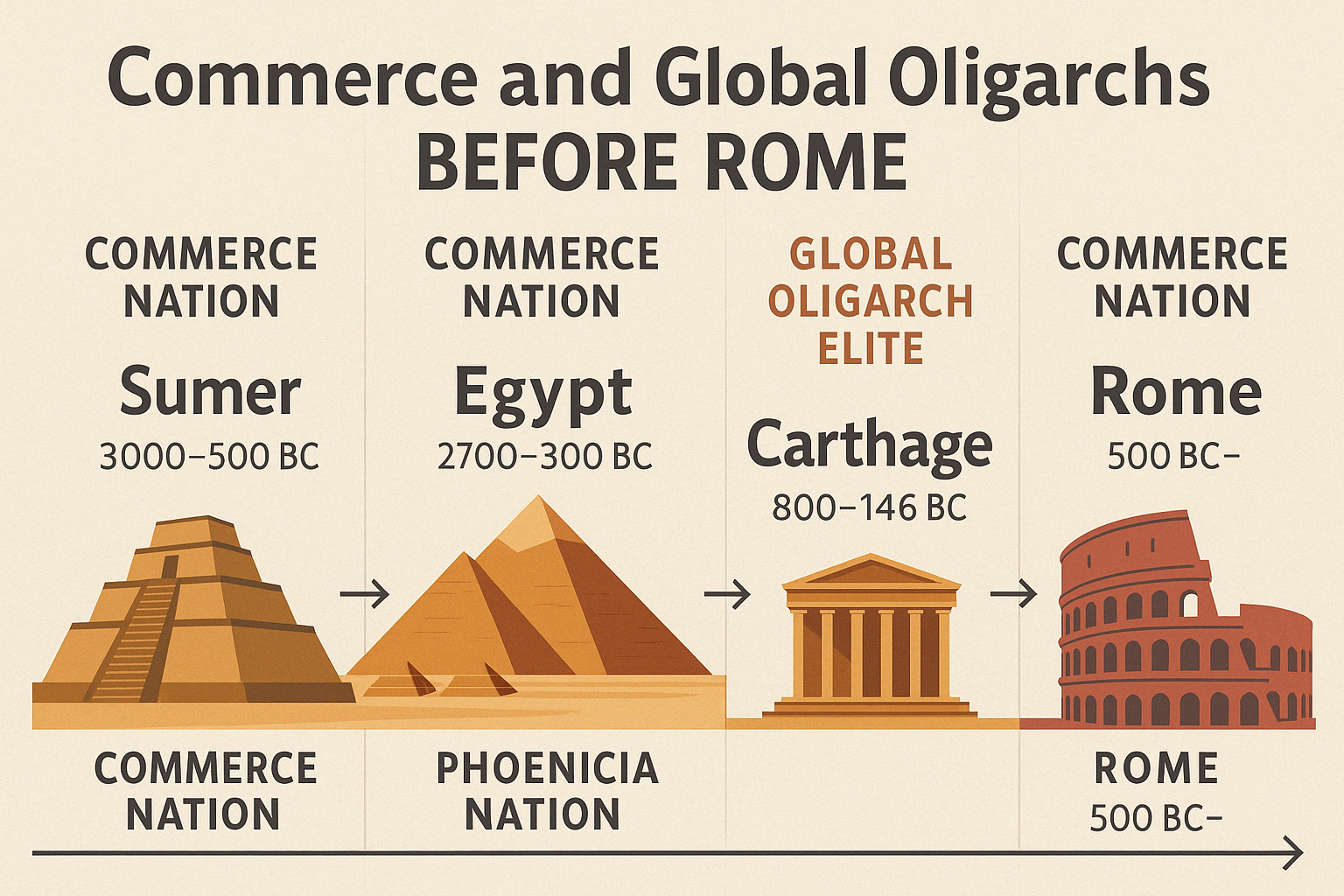Ancient Mesopotamia (Sumer, Akkad, Babylon – 3000–500 BC)
- Earliest City-States: Sumer (e.g., Uruk, Ur) created the first known urban economies.
- Commerce and Banking:
- Developed cuneiform accounting systems.
- Created temples that acted as banks: stored grain, loaned goods.
- Introduced early debt systems (e.g., “wiping of debts” or jubilee).
- Elites: Priestly castes and merchant princes controlled commerce and local governance.
First Commerce Oligarchy: Temple-based elites managing wealth, land, and trade.
Ancient Egypt (2700–300 BC)
- Trade and Wealth:
- Nile facilitated internal trade and access to Red Sea routes.
- Pharaohs controlled commerce, but merchant classes (especially during weaker dynasties) gained growing influence.
- Economic Administration:
- Strong bureaucratic control over grain storage, distribution, and foreign trade.
Egypt’s merchant and priestly classes gained temporary but significant influence during periods of pharaonic weakness.
Phoenicians (circa 1500–300 BC)
- Maritime Traders Supreme:
- Based in cities like Tyre, Sidon, and Byblos (modern Lebanon).
- Created the first great merchant oligarchy.
- Contributions:
- Invented alphabet systems (to aid record-keeping and trade).
- Established colonies (most notably Carthage) across the Mediterranean.
- Commerce over Conquest:
- They preferred trading dominance, shipping purple dyes, glass, metals, timber.
The Phoenicians are often seen as the “first globalists” — networked, merchant-centered, focused on controlling trade routes.
Carthage (circa 800–146 BC)
- Phoenician Legacy:
- Carthage became the dominant naval and commercial power in the Western Mediterranean.
- Commerce Power:
- Thrived through trade, taxing, and naval supremacy — not land empires.
- Political Structure:
- Oligarchic governance — powerful merchant families ruled Carthage’s Senate.
- Fall:
- Destroyed by Rome after the Punic Wars (especially 146 BC, Third Punic War).
Carthage represents one of the most direct “pre-Roman” Commerce Nations ruled by global oligarch elites.
Summary: Pre-Roman Commerce Power Lineage
| Civilization | Elite Group | Main Power Base | Key Achievements |
|---|---|---|---|
| Sumer/Babylon | Temple priests + merchants | Land/trade | Banking, debt, contracts, record keeping |
| Egypt | Priests + merchants (at times) | Land/agriculture | Grain banking, bureaucratic administration |
| Phoenicia | Merchant city-states | Maritime trade | Colonization, alphabet, trade dominance |
| Carthage | Merchant aristocracy | Naval trade | Empire of commerce, oligarchic governance |
Direct Path to Rome
- After defeating Carthage, Rome inherited the Mediterranean trade routes.
- Roman elites absorbed Phoenician/Carthaginian commercial practices.
- The Senate’s wealthy Equites class (knights) often engaged directly in banking and tax farming (publicani), echoing earlier Phoenician merchant oligarch models.
Thus, Rome didn’t invent global commerce oligarchy — it inherited and militarized it.
In Short
Before Rome, the global “commerce nations” were Mesopotamian cities, Egyptian dynasties, Phoenician mariners, and Carthaginian merchants.
Each evolved greater financial tools, merchant dominance, and eventually became the hosts for early globalist structures — until Rome consolidated them by conquest.
The Rise of Commerce Nations Before Rome: Expanded Historical Guide
Commerce Nation Timeline Before Rome
Ancient Mesopotamia (Sumer, Akkad, Babylon) – 3000–500 BC
- Location: Fertile Crescent (modern Iraq).
- Elites: Priestly rulers and emerging merchant classes.
- Power Base: Agricultural surpluses, temple banking, early international trade.
- Innovations:
- Cuneiform writing for contracts and accounting.
- The Code of Hammurabi: one of the earliest codified legal systems.
- Earliest recorded debt systems and promissory notes.
Ancient Egypt – 2700–300 BC
- Location: Nile River Valley.
- Elites: Pharaohs, priesthood, growing merchant classes in weaker periods.
- Power Base: Agricultural wealth, trade expeditions, state-run granaries.
- Innovations:
- Hieroglyphic record-keeping.
- Granary “banks” storing and lending grain.
- Early taxation and labor conscription systems.
Phoenicia (Tyre, Sidon, Byblos) – 1500–300 BC
- Location: Eastern Mediterranean (modern Lebanon).
- Elites: Merchant aristocracy.
- Power Base: Sea trade, shipbuilding, and the establishment of trade colonies.
- Innovations:
- Alphabetic writing systems (precursor to Greek and Latin alphabets).
- Multi-city commercial networks spanning the Mediterranean.
Carthage (Phoenician Colony) – 800–146 BC
- Location: North Africa (modern Tunisia).
- Elites: Wealthy merchant houses and a semi-republican oligarchy.
- Power Base: Dominance of sea trade routes, colonial taxation, military mercenary system.
- Innovations:
- Proto-corporate merchant organizations.
- Expansion of banking and credit systems across the Mediterranean.
Transition to Rome – 264–146 BC (Punic Wars)
- Result: Rome’s destruction of Carthage led to the absorption of Phoenician trade networks.
- Shift: Roman aristocrats adopted Carthaginian and Phoenician commercial practices, integrating them into Rome’s imperial system.
Key Insights, Legacy, and Bonus Section
How Commerce Elites Operated
- Global Trade Networks: Linking civilizations via land caravans and maritime routes.
- Banking and Finance: From temple treasuries to private merchant lending.
- Legal Systems: Early international laws to regulate commerce across cities and empires.
- Naval Power: Essential for securing trade lanes and expanding influence.
Patterns of Migration and Influence
- Sumer to Babylon: Codified legal and economic structures.
- Babylon to Egypt: Merging financial and state administrative innovations.
- Egypt to Phoenicia: Rise of maritime mercantile power.
- Phoenicia to Carthage: Colonial expansion and naval dominance.
- Carthage to Rome: Integration of commerce with military imperialism.
The Global Oligarchic Strategy
- Follow Stability and Prosperity: Embed within rising political powers.
- Dominate Trade and Finance: Secure monopolies over routes and goods.
- Steer Governance: Influence legal, economic, and military policies to protect and expand their interests.
Reflection: “Commerce does not bow to kings—it moves to where kings must bow to commerce.”
Earliest “Financial Families” and Merchant Dynasties
Sumerian & Babylonian Houses
- House of Ur:
- Managed temple wealth and city-state treasuries.
- Earliest “family offices” dealing in land, grain, and trade goods.
- Priestly Bankers of Babylon:
- Operated early debt contracts.
- Managed temple-backed financial instruments.
Egyptian Financial Elites
- Temple Clans of Thebes and Memphis:
- Controlled surplus wealth.
- Loaned grain and resources during famines and wars.
Phoenician Merchant Families
- House of Tyre, House of Sidon:
- Created intercity commercial guilds.
- Established daughter colonies (like Carthage) ensuring dynastic continuity.
Carthaginian Merchant Clans
- Mago Family, Barca Family (Hannibal’s lineage):
- Combined military leadership with merchant wealth.
- Financed Carthage’s wars and trade expansion.
Summary: Long before Wall Street or the City of London, ancient “financial families” shaped civilization’s trajectory—using trade, credit, and politics as tools of global influence.







